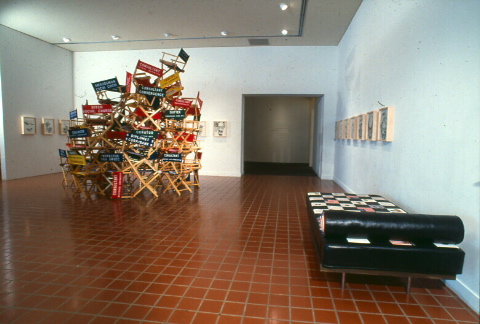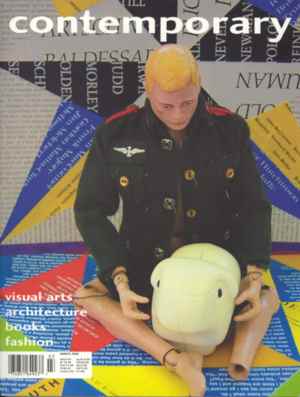>>SELECTED CRITICAL REVIEWS<<

... "Social Fabric" is Trasobares's latest commentary on consumption,
institutional excess, Cuban politics, and sexual appetite. An artist, curator,
collector, and
art activist, Trasobares has worked in Miami for three decades. He's shown
here and elsewhere and his output has remained constant. Yet Trasobares
is not as
well-known as he should be and his own artistic independence may have to do
with it. He prefers to keep art separated from business to be free
to engage in social
discourse.
"His mix of tension and sarcasm resembles Marcel Broodthaers's appraisals
of the art market. Broodthaers, the late Belgian conceptual artist, created -
like Trasobares - conspicuous museum like displays. In addition a "surrealist" Cuban-exile
touch can be discerned in Trasobares's critique. "Social Fabric" is
a protest, a paradox, a slip-of-tongue, a combination of Pop and satire.
“… Though invested with a more overtly political agenda, Elian
in Wonderland (1972-2001),
by Cesar Trasobares, also destabilised any self-contained notion of 'art'. Like
some parallel version of Jeremy Deller's archiving of British
folk art, the installation was the result of almost thirty years spent
collecting hundreds of objects from Miami's large right-wing, Cuban ex-pat
community. This period culminated in what was the focus of the collection: the
furore surrounding the repatriation of Elian Gonzalez. Amongst the wall-pinned
photographs of protesters, anticommunist banners, and T-shirts proclaiming
Janet Reno's thralldom to Castro, were cabinets containing home-made
crucifixes, ugly Clinton caricature dolls, and mutilated Action-Man figures
dressed in Nazi uniforms with Stars-and-Stripes patches. Trasobares's
curatorial project negotiated a fine line between appreciation for these
cultural artefacts and censure of the lunatic sentiments behind them. …”
Gabriel Coxhead, reviewing globe>miami<island
Contemporary, March 2002
“… An exhibition within an exhibition is Cesar
Trasobares's Elián in Wonderland, a multifaceted installation displaying
trinkets of all sorts, cheap figurines, toy soldiers, Barbies and Kens, along
with original
posters, from the Elian days and -- just for the opening -- a live young model
inside a fish tank with two inflatable dolphins. It's a microcosm of Cuban
culture, nationalist kitsch, and caustic analysis worth more than any textbook
on the subject. …”
Alfredo Triff, “Take a Bow …” Miami New Times, 3-9 January 2002
“En 1983, Christo "envolvió" once cayos de Miami
en un gesto formidable y bastante sorprendente. Sobre todo si tenemos en cuenta
que lo hizo en una ciudad en la cual, tanto entonces como ahora, el arte y la
calle están radicalmente divorciados. (Incluso podría decirse que el kitsch de
la galería —abundante tambien— no es el kitsch de la calle). Unos aĖos antes,
César Trasobares habia seguido un camino inverso si bien con propósitos similares.
En una de las indagaciones más interesantes que se han realizado sobre la
cultura popular y visual cubana en Estados Unidos, Trasobares realizó su serie
de quinceaĖeras
a finales de los 70, junto a varias perfomances encaminadas a quebrar
la división
apuntada entre el "arte" y la ciudad. Este artista, además, dirigió
como comisionado público un proyecto urbano que representó a Estados Unidos en
la Trienal de Milán de 1988, dedicada a las ciudades.
Posiblemente, Trasobares y Christo hayan ejecutado los
actos más importantes por hacer del arte en Miami una "cosa pública".
De paso, sus proyectos se dirigieron a activar el discurso visual de una ciudad
—más bien un archipiélago urbano— a la que Europa o parte de los propios
Estados Unidos han acreditado como una capital del "easy money", el
turismo, el kitsch latino, en otro tiempo del narcotráfico, de la segregación
racial o del anticastrismo (todo eso, a veces, explosivamente unido), pero no
como una capital del arte o algo por el estilo. Entre el gesto de Trasobares
—llevar la estetica popular a la galeria para resemantizarla— y el de Christo
—realizar un environment fuera de la institución convencional e implicar a la ciudad— medió el
arribo, por el éxodo de el Mariel, de varios artistas y escritores, quienes
portaban una diferencia estética, racial, sexual y cultural considerable con
respecto a lo que estaba acostumbrado a asumir y consumir ese Estado. Así,
cuando tiene lugar la redefinición del arte en los 90, esta no parte de cero.
…”
Iván de la Nuez, “Redefiniciones en los 90,” LAPIZ, December 1996.
Cesar
Trasobares has ingeniously rocked the status quo throughout his far reaching
career as an artist and art activist. Born in Cuba and bred in Miami, he began
deconstructing the iconography of exile culture in his conceptual artworks back
in the Seventies, long before Cuban imagery had achieved its current trendy
status. The local market encourages painting, but Trasobares expresses himself
with needlepoint pillows carrying messages that critique the art world,
sexually evocative ready-made objects, imaginary designs for teenage girls’ quince
dresses, and
elaborately-drawn diagrams of museum administration hierarchies. As executive
director of Metro-Dade’s Art in Public Places program from 1985-90, Trasobares
left our local landscape a legacy of works by Edward Ruscha, Richard Haas,
Carlos Alfonso, and others. He has served on numerous national curatorial
committees, grant panels, and NEA boards, always advocating the basic need for
(uncensored) art in America. A staunch supporter of younger artists, he
encourages them to defend their creative freedom. Trasobares is what an artist
should be – an active citizen. He is our choice because we admire his artwork,
but also because he tries to make Miami a better place for art.
Judy
Cantor, “Best Local Artist,” Miami New Times
22 – 28
June 1995

“…in
the CFA lobby, Miamian
Cesar Trasobares has installed Museum of American Democratic Art: Tumbling
Chairs, which poses this question: Do
American museums represent another sort of "fragile ecology"? Taking
the canvas directors chair as his metaphor, Trasobares (a keynote speaker at
Thursday's opening of the ninth conference of the National Association of
Artists' Organizations) suggests that museums have become the locus of
colliding forces, interests and agendas. He piles up 60 chairs in a pyramid,
their backs identifying the seat of power each represents, with "DlRECTOR:
Museum Marketing" at the top and these elsewhere in the pile --
"CURATOR: Blue Chip Artists," "WOOER: Artists' Estates,"
"TRUSTEE: Latino Powerhouse," "CONSULTANT: Global
Esthetics" and even "V.P.: No Food, No Drink." The seats of
every chair are screened with the M.A.D.A. logo in Gothic script, including the
phrase "showcasing the gorgeous mosaic of our cultural fabric." Remind
me never to use any of those words again.”
Helen Kohen, reviewing the exhibition, Fragile
Ecologies and
Trasobares’ installation at Center for the Fine Arts,
The Miami Herald, 1 May 1994
"… In a more critical
vein Cesar Trasobares' installation explores the social rituals of Cuban
culture such as the Fiesta, a ball in which a 15 year-old girl makes her
society debut and displays her talents. White dresses embellished with beads or
sequins and empty picture frames evoke the disordered atmosphere of an
old-fashioned attic after the ball. On the wall are collaged, framed mementos -
fragments of gloves, purses, jackets, and other costume pieces presumably worn
on these occasions that constitute portraits of people or situations related to
these celebrations. On the wall beside these framed assemblages, fragments of
conversations are inscribed: 'Does he come from a good family?' 'Are they
upper-class?' While the glitz and glitter of these festivals are clearly
celebrated, there is also a sense of 'framing,' almost as if the artist were a
sociologist or archaeologist recording ... viewpoint of most Cuban Americans
encountering this exhibit. This postmodern consciousness has the curious effect
of showing the artist who lives between two cultures as already self-conscious
and alienated from his own cultural experience. This sense of 'otherness' is a
constant undercurrent of this exhibition. …"
Cris Hassold, Review of "Cuba-USA: The First
Generation", Art Papers, January 1993
"… Other artists take a more ironic stance vis-a-vis
Cuban customs. Take the work of Cesar Trasobares, a Miami painter turned
cultural anthropologist. His subject is the life and times of a fictional
character he calls Rosata QuinceaĖera. She is the quintessential Miami Cuban
girl whose coming of age at 15 is celebrated with an elaborate and expensive
party known as the Fiesta de Quince. A combination debut, talent show and
heritage festival, the Quince often requires professional choreographers and second
mortgages. Trasobares simultaneously parodies and memorializes this Cuban
potlatch. His fascinating collages combine programs, mementoes and clothing
-tuxedoes and frothy white formals--with trinkets, photographs and newspaper
clippings in a poignant portrait of what he calls "a dying modern
ritual."
Mary Abbe, "A Potent Mix of Cultural Symbols:
CUBA-USA Show Views Are Unique," Star Tribune, 2 February 1992

"...Trasobares...
takes this opportunity 'to chart my own trek out of the ghetto' of Cuban-American
art. He transforms the ball gowns of the quinceaĖera into the materials of a
raft, that powerful political symbol for Cuban exiles, The walls around the
craft are painted to suggest a map of Cuba, a sea and swimmer emerging free of
the water, and everywhere there is graffiti, 'What Cuban art?' Trasobares
writes on a supporting column, which, he says, marks his 'transition from the
residual of a Cuban background to free space.' What appears to be a statement
about Cuban-American politics is really about art politics. ..."
Helen Kohen, "Cuba-USA: Enormous Exhibition by
Artists Who Left Their Homeland Offers Viewers a Look at the Face of
Miami", The Miami Herald, 3 May 1992
"...Cesar
Trasobares revels in the miniature. His massive collection of rings, from the
souvenir glitter of 'Texas Engagement Ring' to the fine carving of an African
ring, has inspired his art. This former director of the Metro-Dade Art in
Public Places sees rings as intimate and infinitely various cultural artifacts,
signs of the wearer's power or allegiance to other people. They encompass many
meanings: 'I find a ring in almost anything,' he says.
In his installation at Gillman are several glass cases
full of his collected rings and those he has made. Some strike arty witticisms,
including his 'Ed Ruscha' ring, bearing the message 'Such Read.' It's an
anagram of the name of that artist, whose word paintings include those circling
the rotunda of Miami's Main Library. Another, a tiny soft sculpture a la Claes
Oldenburg, is printed with stock market quotes - a soft market indeed.
The show gives us a look at Trasobares' mercurial
imagination, his puns and wry jokes. Some jokes carry an activist edge,
including the cast copper art soldier, a toy-sized GI Joe armed with books and
paper. While the rings and soldiers can make their points quickly, Trasobares'
poetic drawings stand out. Images of rings, maps, and even newspaper clippings
about rings are layered over pale washes of color that briefly describe land,
sea and sky. They are dreamy charts of experience, comparing the artist's role
to a rafter navigating risky currents limning the globe."
Elisa Turner, "Gillman Show Takes a Circular
Tack", The Miami Herald, 27 November 1991
"Cesar
Trasobares is the one artist in the group who confronts the bicultural
situation absolutely head-on, in a piece from his 'QuinceaĖera' series, The
work is a shrine-like assortment of elements from the real world - Cuban and
American flags, a striking white gown of the kind a 15 year-old Cuban girl (a
'quinceaĖera') might wear to her coming out celebration, a few scrap-book
mementos - combined with a veiled collage composition that hints at secret
pleasures or pains or disappointments..."
Benjamin Forgey, "The Cuban Evolution", The
Washington Post,
14 June 1984
"The ritual of the quince is rooted in powerful
assumptions about the relationships between the sexes. The material in the
exhibition that simply documents it is often the most interesting, because of
the intricacies of personal theater and public fantasy it exposes. In the 'Las
Chaperonas' series, Trasobares has succeeded in transforming his documentary
material into art, perhaps because he has distinguished the superficial from
the profound aspects of the ritual and the relationship it formalizes... "
Paula Harper, "Exhibit Pokes Fun at the Quince", The Miami News,
15 June 1984
